A jewish cemetery, Krnov
History of the cemetery
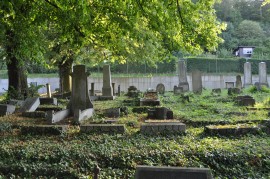
An establishment of own cemetery was a great achievement of Krnov Jewish community. Due to this reason, a large land under Cvilín hill was bought in 1873. The land is sloping from the southwest to northeast towards Opavská street. First funerals were probably held in 1874 (this years is marked on the oldest tombstones).
Only a minority of tombstones is typically Jewish desk tombstones from “pre-emancipating” period, which occurred at older cemeteries. Most tombstones are commonly used ones, so typical on Christian graves. Only older tombstones include inscripts in Hebrew, otherwise German dominates.
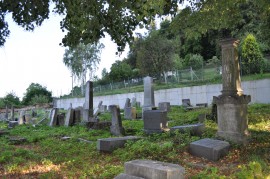
Since the very beginning of the Jewish cemetery, more than 500 deceased Jewish community members from Krnov, Bruntál, Rýmařov, Osoblaha and other surrounding villages, including some villages of Prussian part of Silesia. During the World War I, also refugees of Jewish origin from Halič and Bukovina, evacuated from these lands in the period of Russian offence, were buried here.
The church complex was continuously completed with a ceremonial hall (1902), farm building (building date unknown) and the house of Jewish cemetery caretaker. Out of these buildings, only the caretaker´s house is preserved. On the land, also a well with a cast-iron pump was dug up and it preserved up to now.
The farm building served as a barn for hearse, storage of horse harness and tools. The building was placed in the central part of the land, at the place of contemporary garden sheds (while filling up the cellar premises, parts of horse harness were discovered).
Division of cemetery
The upper part of the cemetery land, filled with tombstones, is divided into four different-sized quadrants by a footway network. The two upper quadrants ( southern and western) are fully fillded with tombstones in regular rows. The two smaller quadrants (eastern and northern) are only partly filled, many gravestones in the area are damaged (including the largest crypts) In the bottom north quadrant, children´s crypts were situated, but only few of them have been preserved. The crypt of rabbi Anschlowitz ( only its photograph has been preserved) was propably situated in the same place. In the bottom east quadrant, a crypt of classicist shape belonging to Bellak family dominates. In the southeast part of the cemetery, nearby the wall, a memorial for buried Jewish soldiers was built here. The memorial also included a text: “Herein, eight Jewish soldiers rest in peace, 1914 – 1918“ (A few Russian soldiers of a Jewish origin, who died in nearby captive camp, were said to be buried here during the World War I).
The cemetery served its purpose till 1970´s, although the frequency of postwar funerals was very low. In the southeast part of the land, adjacent to V Osadě street, a detached house was built by the house of former cemetery caretaker. Because of the regime political pressure in the second half of 1980´s, the cemetery was disestablished and the most valuable tombstones were sold to stonework companies. Only one out of the large crypts was preserved – the one of Bellak family (the family that owned a cloth company here in Krnov).
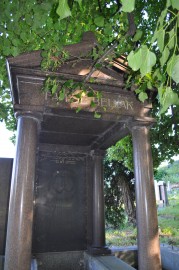
Other crypts – including th crypts of the first Krnov rabbi Anselm Anschlowitz and Mondschein family, were completely taken to pieces or stolen. The major part of tombstones, which were not removed, were laid down and damaged. Some tombstones were even put into newly built houses´ groundings. Thanks to the fall of totalitarian regime, the demolition of the cemetery was not finished. The cemetery suffered from vandal interference and dilapidation. The bottom part of the cemetery, including areas still unsused for burying, was sold to private entities and garden colony was established here. What has left to Jewish community out of a large original property was just a fragment – the land of 2,500 m2, which is only one fourth of the original size. The cemetery urgently calls for fencing to prevent vandals from free access and an establishment of regular maintenance of green areas (now complicated because many tombstones are broken and lying on the ground).

Curiosity - the crypt in a sarcophagus shape
Only one tombstone is a typical tumba – the crypt in a sarcophagus shape (the tumba resembles a small house – the frontage of tumba, side walls and the roof of saddle shape are made from stone slab). Such a tombstone type was used mainly by important Jewish community members (tombs of Prague rabbis are famous). A Neo-baroque tomb in belongs to doctor Oskar Bubera, who died in 1910. An Art Nouveau tombstone of Heinrich Goldberger from 1909 is also remarkable. A very simple symbology is used on tombstones – David´s star, Cohens´ blessing hands and the Levites container.
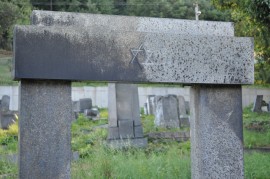
The ceremonial hall of Jewish cemetery - Opavská street (Troppauer Strasse), Krnov
After the final completition of the Synagogue and establishement of cemetery, the Jewish community of Krnov made final decision to build up also a ceremonial hall. Ernst Latzel was intended to design the project, because his company had realized a few building projects for Jewish community before. The project design was completed in July 1902 and in the beginning of September of the same year, a bulding permission was issued.
The ceremonial hall was built in the bottom part of the cemetery, nearby the Opavská street. It was a simple building of a rectangle floorplan with dimensions 11,2 x 12,9 m.
Unfortunatelly, the memorial hall is not preserved, it was destroyed by Nazis in 1938 (in bottom part of the cemetery, at the place of hall, there are now gardens). The only evidence of the building is now a building plan, deposited in Krnov town hall archive.
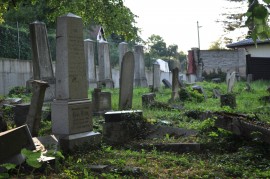
You can also find a Jewish Synagogue and the stones of the vanished, so called Stolpersteins here in Krnov. The present care taker and owner of the church is the Federation of Jewish communities.
ContactThe federation of Jewish communities in Czech Republic +420 608 627 247 |
Opening hours and admissionYou can visit the Jewish cemetery all year long and free of charge. The cemetery is freely accessible and the entrence is at anyone´s own risk. Please enter the cemetery from V Osadě street. |
Map
GPS position: 50°5′5.68″N, 17°43′29.613″E

